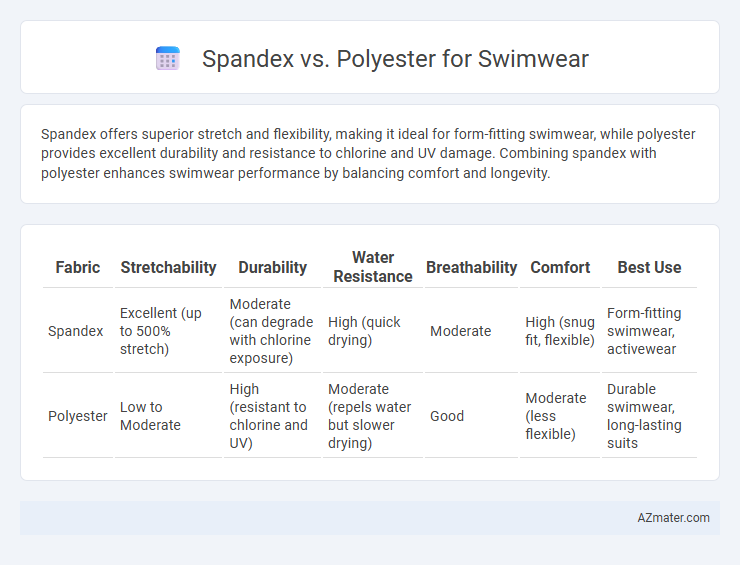Spandex offers superior stretch and flexibility, making it ideal for form-fitting swimwear, while polyester provides excellent durability and resistance to chlorine and UV damage. Combining spandex with polyester enhances swimwear performance by balancing comfort and longevity.
Table of Comparison
| Fabric | Stretchability | Durability | Water Resistance | Breathability | Comfort | Best Use |
|---|---|---|---|---|---|---|
| Spandex | Excellent (up to 500% stretch) | Moderate (can degrade with chlorine exposure) | High (quick drying) | Moderate | High (snug fit, flexible) | Form-fitting swimwear, activewear |
| Polyester | Low to Moderate | High (resistant to chlorine and UV) | Moderate (repels water but slower drying) | Good | Moderate (less flexible) | Durable swimwear, long-lasting suits |
Introduction to Swimwear Fabrics
Spandex and polyester are two dominant fabrics in swimwear, each offering distinct properties. Spandex provides exceptional stretch and elasticity, ensuring a snug fit and freedom of movement, while polyester delivers durability, resistance to chlorine, and colorfastness. Swimwear designers often blend these materials to balance comfort, performance, and longevity in aquatic environments.
What is Spandex?
Spandex is a synthetic fiber known for its exceptional elasticity, commonly used in swimwear for its ability to stretch up to five times its original length and provide a snug, comfortable fit. It offers excellent shape retention, quick-drying properties, and resistance to chlorine and UV rays, making it ideal for active swimmers. Unlike polyester, which prioritizes durability and colorfastness, spandex focuses on flexibility and freedom of movement in swimwear fabrics.
What is Polyester?
Polyester is a synthetic fiber known for its durability, resistance to shrinking and stretching, and quick-drying properties, making it a popular choice for swimwear. It retains color well under prolonged exposure to sunlight and chlorine, which helps swimwear maintain its vibrant appearance over time. Polyester fabrics often blend with spandex to provide the necessary stretch and flexibility required for comfortable and functional swimwear.
Stretch and Flexibility Comparison
Spandex offers superior stretch and flexibility, providing up to 500% elongation without losing shape, making it ideal for swimwear that requires a snug yet comfortable fit. Polyester has less natural elasticity but is often blended with spandex to enhance durability and chlorine resistance while maintaining adequate stretch. The combination of polyester with spandex balances flexibility and strength, ensuring swimwear retains its form during active movement and prolonged use.
Durability and Longevity
Spandex offers superior elasticity and shape retention, making swimwear more durable against stretching and frequent wear, while polyester excels in resistance to chlorine, UV rays, and fading, enhancing longevity in various environments. Swimwear blending polyester and spandex optimizes durability by combining stretch with colorfastness and abrasions resistance. Choosing fabrics with higher chlorine-resistant polyester content extends the lifespan of swimwear without compromising flexibility essential for active swimming.
Comfort and Fit in Swimwear
Spandex offers superior elasticity, providing a snug and flexible fit that moves with the body, making it ideal for swimwear comfort. Polyester, although less stretchable, offers durability and resistance to chlorine, but may feel less form-fitting compared to spandex blends. Swimwear combining spandex and polyester balances comfort, fit, and longevity, ensuring a secure and comfortable experience in the water.
Chlorine and UV Resistance
Spandex offers excellent elasticity but degrades quickly when exposed to chlorine, making it less durable for frequent swimwear use. Polyester, particularly PBT blends, provides superior chlorine resistance and maintains color vibrancy even after repeated pool exposure. UV resistance is higher in polyester fabrics, ensuring longer-lasting protection and less fabric breakdown under sun exposure.
Color Retention and Fading
Spandex swimwear offers superior elasticity and maintains vibrant color longer due to its ability to resist fading from chlorine and UV exposure. Polyester fabric provides excellent color retention by using solution-dyeing techniques, making it highly resistant to bleaching and sun damage. When choosing swimwear, polyester's durability in color preservation often outweighs spandex's stretch benefits for prolonged vibrancy.
Environmental Impact and Sustainability
Spandex, commonly used in swimwear for its elasticity, poses environmental challenges due to its petroleum-based origin and difficulty in recycling. Polyester, particularly recycled polyester derived from plastic waste, offers a more sustainable alternative by reducing landfill contributions and lowering carbon emissions. Choosing swimwear made from recycled polyester supports circular fashion initiatives and helps mitigate microplastic pollution in marine ecosystems.
Choosing the Right Fabric for Your Swimwear
Spandex offers exceptional stretch and shape retention, making it ideal for swimwear that requires flexibility and comfort during active use. Polyester excels in durability, chlorine resistance, and colorfastness, ensuring swimwear maintains its appearance and integrity over time. Selecting the right fabric depends on balancing desired elasticity with long-lasting performance, with many swimwear designs combining both fibers for optimal results.

Infographic: Spandex vs Polyester for Swimwear
 azmater.com
azmater.com